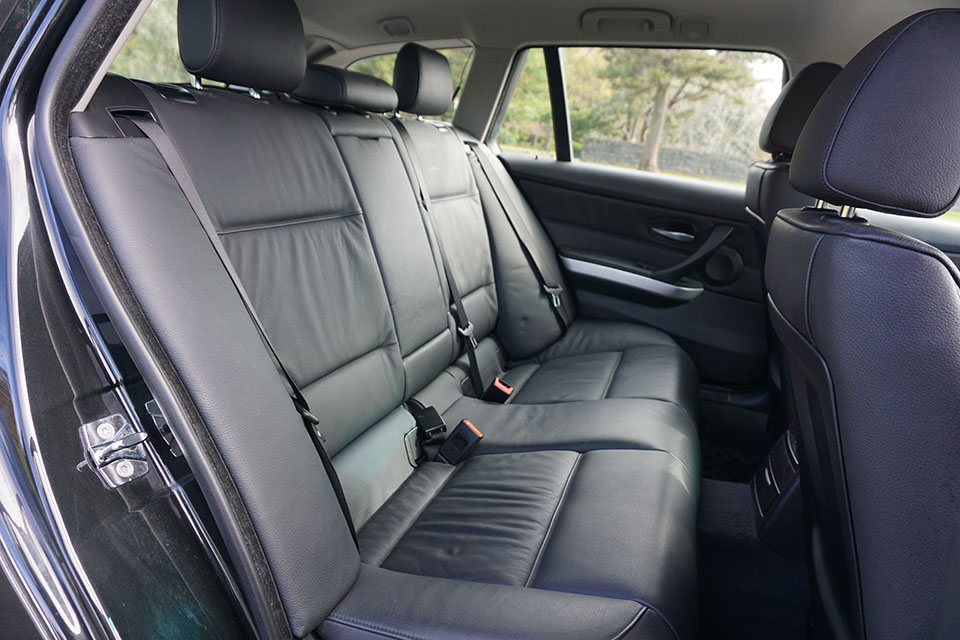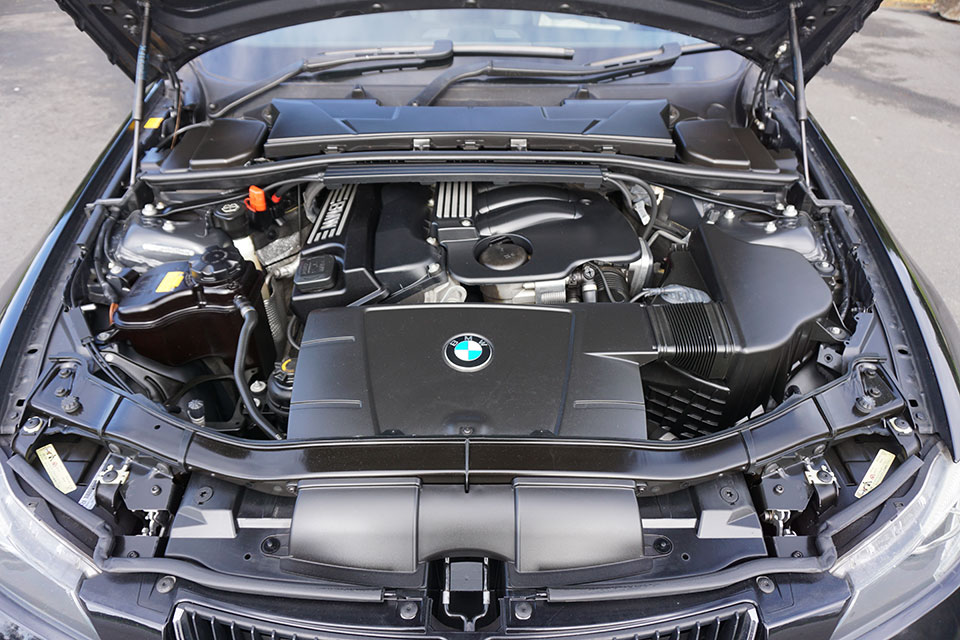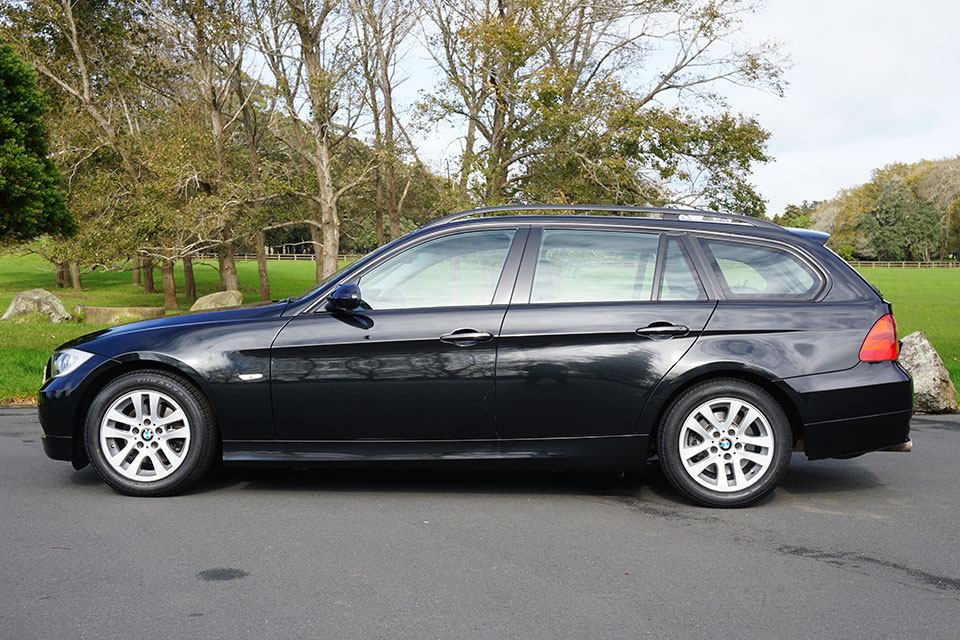BMW 320i 2005-2011 used car review
The BMW 320i offers the best handling in the medium-size car market and is entertaining to drive.

The BMW 320i offers the best handling in the medium-size car market and is entertaining to drive. The engine can be challenging and expensive to fix.
BMW’s 3-series line is one of the most popular and successful premium cars ever offered and the 320i is its most common form. Unlike most other cars in the segment, it is a rear-wheel drive, which provides better handling than front-wheel drive competitors. The 320i is available as a sedan, coupe, convertible and Touring, the wagon version we are reviewing.
Inside and out
The 320i has a sculpted look - its sides look like they are hollowed out in a style called “flame surfacing” by BMW when it was launched. The front sports the traditional BMW “kidney” twin grilles. The rear comes down at an angle and is rounded, which gives the Touring a sportier look than other wagons but also eats into the available space.
Our review vehicle is not fitted with BMW’s “iDrive” infotainment system, which requires a different dashboard design. Instead, its dash design is relatively simple, with a strip of aluminium trim across the full width of the car.
The gauges are huge and easy to read and have a metallic edge to them. In the middle of the cluster are a red trip computer and an information screen. In the centre console is the CD player stereo, again with a red screen, and the separate temperature controls for driver and passenger.
Set into the dash on the passenger side are two pop-out cup holders. The driver’s holder comes out at an angle to reach over to the right-hand side of the car.
The holders are handy although they interfere with the passenger’s space when entering and exiting the vehicle. Our review vehicle is an SE, which means the front seats are covered in black leather. The leather feels high quality.
The driver's seat is electrically adjustable and can remember settings for two different drivers. The seats are comfortable and offer good side support, although taller drivers could find the base is a bit too short to support their legs properly.
Rear legroom is below expectations for a medium-size car and is a result of the car’s rear-wheel drive format. Two adults will fit but the middle seating position is narrow and best for children only.
A note to buyers who have trouble getting in and out of cars: the seating position in the 320i is low, so check you can get easily in and out, particularly the rear seat.
Both the sedan and Touring cars have the same 460-litre boot capacity, well below most others in the class. You can expect to fit two large suitcases. If you load the Touring above the seat level, you will fit in another large or two small cases on top. Space under the boot floor can store smaller items and is available because the car uses run-flat tyres so does not carry a spare.
On the road
Before this generation 320i, the model was known for its smooth six-cylinder engines. To improve efficiency, BMW shifted to a new 2-litre four-cylinder engine. We found the car sounded a little like the six-cylinder, with a gruff, sporty tone to it.
The engine in our review vehicle produces 110kW and 200Nm and felt disappointing to drive, with only adequate power for the size of the car. With a full load on board, you will need to plan extra distance for overtaking. BMW made the engine more powerful as part of updates in 2007 and 2011.
Versions of the 3-series are available with engines ranging in size from 1.6-litres to 4-litres. We were very impressed by the six-speed automatic transmission, which is smooth and very smart to shift. It can be set to sport for more aggressive driving or changed manually. A six-speed manual is an option, although for most drivers the automatic will be the better choice.
Apart from its lack of power, the 320i is nice to drive. The steering feels very direct, well-weighted and responsive. Grip through corners is excellent and the car is easy to keep on your intended line. The brakes are also very responsive and stop the vehicle quickly. The suspension is on the firm side for a family sedan.
With its low sitting position, visibility out of the 320i is slightly restricted, particularly to the rear. Reversing cameras were optional on cars with the iDrive infotainment system. Parking sensors are common on New Zealand-new cars but less so on imports. If the BMW you are looking at does not have a reversing camera, we recommend adding one. Fitting a camera yourself costs from $50 or a professional will do it from $200.
The 320i can tow up to 1,400kg braked (a small to medium trailer boat), which is average for a medium-sized vehicle.
Safety
RightCar shows the 320i (2005-2013) as having a five-star Used Car Safety Rating, based on real-world crash data. Standard safety specifications are high – and include front, side and curtain airbags. Electronic stability control and electronic brakeforce distribution are also standard.
ISOFIX child seat mounts are found in the rear seat window positions. All three rear seats feature full shoulder-style belts, which offer more protection than lap-only belts.
Reliability
The engine in the 320i uses a timing chain that will not require regular replacement, although there have been some issues of stretch at higher mileages (i.e. nearing 200,000km) – so avoid cars that are running rough or have flat spots in their performance.
Oil consumption is an occasional issue with the 2-litre unit as well. That’s caused by a failure of the valve stem seals or piston rings and attributed in most cases to poor maintenance and lower quality oils. Check for signs of grey-blue exhaust smoke when the engine is under load and monitor the oil levels.
If oil consumption and smoking becomes excessive, the only solution is a full rebuild, costing more than $2,000. The fuel injectors and coil packs are also known to give trouble and it’s often difficult to accurately diagnose without replacing all four injectors or coils.
Costs for repairing and servicing the engine are made more expensive by its placement far back into the firewall of the engine bay. That was done to improve handling but makes access difficult if any work needs to be done.
Replacement costs start from a few hundred dollars, although that can rise if the area affected interferes with the curtain airbags. A widespread issue is “sticky” exterior door handles - they pull out when opening the doors but refuse to latch back in. In most cases, they can be fixed cheaply by carefully cleaning and lubricating the mechanism with CRC lubricant.
Cost of ownership
BMW recommends servicing the 320i every two years or 25,000km, whichever comes first. The car has a system that detects if the vehicle needs more frequent servicing and will let you know through the information screen between the gauges. A BMW dealer quoted $600 for the two-year service and $800 for the four-year service.
RightCar estimates that over 14,000km of driving a year, a 320i will cost $2,660 to fuel. The 63-litre fuel tank will cost $126 to fill at $2 per litre and should take you 600km before the fuel light comes on.
A vehicle licence for the 320i costs $76.20 a year, with the car in the cheapest ACC levy group.
Trade Me Insurance estimates insurance for a 320i Touring valued at $10,240 will cost $54.81* per month. This is $3 cheaper than an Audi A4 of the same year.
Buyers' guide
The 320i is available on Trade Me from $5,500 to $25,000 for later and lower mileage vehicles. Facelift model cars from 2008 on are worth significantly more, with prices jumping around $5,000 between the old model and the new version.
Variants
- Standard – CD and MP3 player stereo, automatic headlamps, rain-sensing wipers, fabric seats, alloy wheels, manual air-conditioning.
- SE – Adds leather seats, cruise control, climate control air-conditioning and electric driver's seat with memory function.
- Innovations package – Adds heated front seats and BMW’s iDrive infotainment system, which includes an LCD screen controlled by a multifunction dial between the front seats, satellite navigation and parking sensors.
- Motorsport package – Adds sports seats and steering wheel, sports suspension, body kit, spoiler and 18-inch alloy wheels.
Timeline
- 2004 Launched globally
- 2005 Production of Touring version begins
- 2006 Production of coupe and convertible versions begins
- 2007 Engine updated to provide slightly more power
- 2008 Facelift with new bumpers, wing mirrors, headlights, bonnet, boot lid and grille
- 2011 Sedan replaced by new model
- 2012 Touring replaced by new model
Details
2006 BMW 320i Touring
$6,500 to $22,000 for models which have travelled 70,000 to 120,000km
Six-speed automatic, rear-wheel drive
2-litre four-cylinder, 110kW and 200Nm
Five-star Used Car Safety Rating
Variable depending on use
Run flat tyres
9.5-litres per 100km (claimed)
Premium
4520mm
1820mm
1420mm
1400kg (braked)
11m
This review covers the BMW 320i for model years 2005, 2006, 2007, 2008, 2009, 2010 amd 2011.
Review vehicle supplied by City Motor Group.
*Our insurance estimates are based on a 35-year-old male with no accidents in the last two years, garaging the car in Mission Bay, Auckland. The car is not used for business and will cover 10,000km to 20,000km a year. We estimate with no option add-ons and $500 excess. Customise your estimate at Trade Me Insurance.
Image gallery
Also consider







